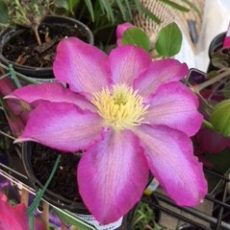Your cart is currently empty!

How To Grow Clematis in Perth
Clematis are renowned for their large, delightfully coloured flowers in many different varieties. They are one of the most beautiful climbers available.
Position
Clematis originated in woodland conditions and so they will benefit from a sheltered aspect. They need their roots planted in a spot and space for the stems to grow up into the sunlight.

They will flower best when enjoying about six hours of morning sunlight a day. They need to be protected from harsh afternoon sun and Perth’s late afternoon heat in warmer months. Also, avoid windy positions when deciding on a spot to plant.
Clematis need a support to climb on and look stunning when grown on an obelisk, arbour or a feature wall. Also, they can be trained to grow up trees or ramble as a ground cover. They are a deciduous climber so consider this when planning your garden. The bare tracery of branches can be an attractive feature when they are dormant in winter.
Soil
Clematis have deep roots and like free draining, organic rich soil. Before planting, ensure you choose a suitable position and dig through soil improver and compost. If you can’t find the right spot in the garden, you can grow clematis in a large pot with premium potting mix. Use a slow release fertiliser when planting and ensure that the soil is mulched well to keep the roots cool.
Watering
Clematis require consistently moist (but not wet) soil. Depending on your soil type and preparation, this may mean a couple of deep waterings a week. In pots, they will dry out faster and may need watering more often during hot weather.
Fertilising
Clematis are heavy feeders and benefit from combination feeding of a good quality controlled release fertiliser accompanied by liquid feed during periods of active growth and flowering.
Pruning
Develop a sturdy framework of stems by pruning clematis hard when they are young. This should be done when dormant buds are swelling and about to burst. A good prune at the right time will allow the plant to put more energy into the remaining growth and develop a strong structure, much like with roses. Check your plant’s label for individual pruning requirements. There are three basic groups based on where the flowers appear on the plant.
Group 1: Spring flowers develop on the previous season’s growth and require less pruning.
Group 2: Spring flowers develop on the previous season’s growth and summer/autumn flowers appear on new growth.
Group 3: Late spring to autumn flowers develop on new growth.
Why not try growing some Clematis for yourself? Shop Clematis
General advice only. Please ask one of our Horticulturists if you require specific advice for your situation.
Recomended Further Reading

Drought Proofing Perth Soil
Read More: Drought Proofing Perth SoilThis short guide teaches you how to drought proof Perth’s unique soils (sandy and clay). Learn about organic matter, mulch and how to avoid problems such as fungal growth.

Autumn in Your Perth Garden
Read More: Autumn in Your Perth GardenLearn what to do in your Perth garden in Autumn, a complete guide to pruning, lopping, feeding and mulching, repotting and more.


